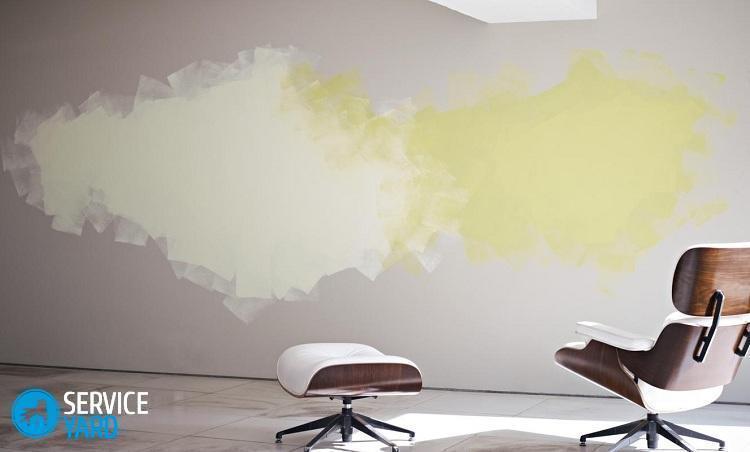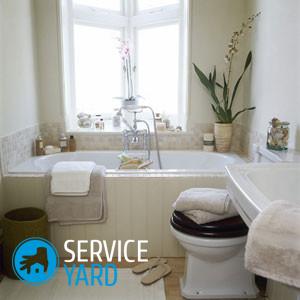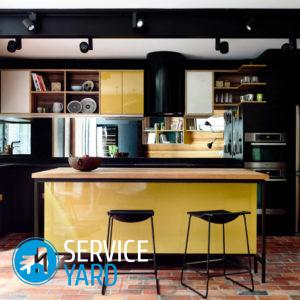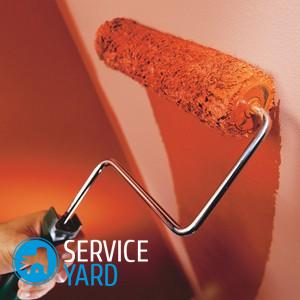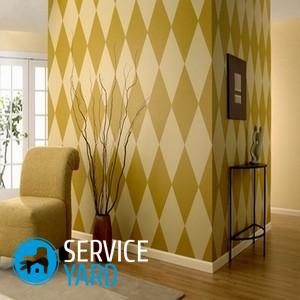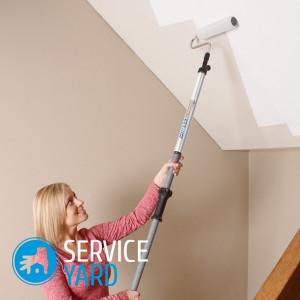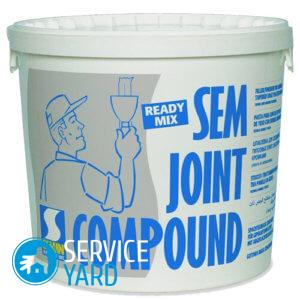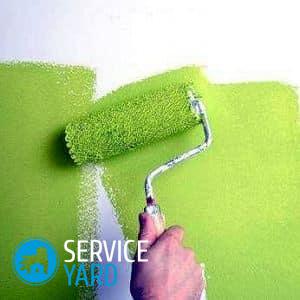Painting concrete walls in an apartment
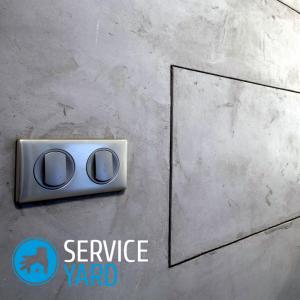
Concrete is a fairly durable material, which is mainly intended for the manufacture of solid structures. These include columnar and strip foundations, load-bearing walls, floors, tiles, beams. Unfortunately, despite their high strength, such structures need special protection from the negative effects of various environmental factors, especially humidity. Painting concrete walls is not only a decorative coating, but also the protection of such elements from their premature destruction. In addition, painting concrete walls in the apartment allows you to create a modern and original design, spending a minimum of money and physical effort on it.
to contents ↑We choose the coloring compounds
Concrete walls are painted with special coloring compounds that will hide the surface imperfections and provide it with a smooth coating. Most often for these purposes I use the following formulations:
- Epoxy paints. They have high resistance to moisture and premature wear.
Important! When using such decorative coatings in the room, good ventilation should be taken into account.
- Coloring formulations based on acrylic and latex. Acrylic Wall Paints low toxic and resistant to temperature extremes.
- Glossy. Such paints have a pretty attractive appearance. Unfortunately, a significant drawback of these coloring compounds is their susceptibility to various mechanical damage.
Useful Tips:
- Pay attention to the fact that high-quality coloring compounds do not require preliminary dilution and are able to paint surfaces even in a cold room.
Important! Do not forget about the purpose of the room, since ordinary acrylic interior paints are suitable for painting a bedroom or living room, but it is better to purchase a kitchen or bathroom odorless waterproof paints.
- When choosing a paint, it is very important, in addition to its main characteristics, to pay attention to the color palette, as the design of the room will depend on this. As with other finishing materials, the same rule applies in this case: for small rooms it is best to choose bright colors, and for large ones - dark.
to contents ↑Important! When choosing a color palette for wall decoration, pay attention to the fact that there are cold and warm colors. The first can be attributed to all shades of blue and green, and the second - red and yellow.
Also, determining the style of the room, browse our articles with interesting ideas:
Tools and materials you need in your work
To carry out work on the preparation and further painting of concrete walls, you will need the following tools and materials:
- Putty knife for applying a leveling layer of putty;
- Drill with a nozzle for kneading putty;
- Paint roller and primer;
- Brushes for painting hard-to-reach spots;
- Capacity for kneading putty;
- Plastic tray for paint;
- Sander;
- Capacity for washing the tool;
- Sandpaper No. 50-60 and No. 80-100 for finishing grinding;
- Ladder;
- Necessary protective equipment (appropriate clothing, glasses and gloves);
- Gypsum putty;
Important! Try to buy putty in a dry form, as it is more economical.
- Soil solution;
- Paint;
- Masking tape.
We carry out decorative wall decoration
Before painting a concrete wall, it is very important to carry out a series of preparatory work on this surface. Due to this, the adhesive properties of your chosen finishing material will be strengthened, respectively - the duration of operation will also increase.
Concrete wall preparation before painting
In order to prepare the walls for painting, you need to adhere to the following procedure:
- Check the walls for humidity. To do this, glue a piece of plastic film to the surface with tape and leave for a day. If condensation appears after this time, this means that the humidity is too high.
Important! Pay your attention to the fact that it is strictly not recommended to paint on wet structures and those that do not have another month from the moment of their manufacture.
- Remove the old decorative finish from the wall surface.
- Wash the wall of dust and dirt. This can be done with plain water. If the dirt is large and cannot be removed, you should treat the surface with rosin.
Important! If there are traces of soot on the wall surface, they can be removed using a calcined solution, and rust spots can be removed with a 15% solution of copper sulfate.
- Level the surface of the wall in order to get rid of small irregularities and roughnesses.
- Treat the surface with acid-salt solution. This is necessary to strengthen the top layer of concrete.
Putty
In addition, before painting, concrete walls must be puttied. This should be done in two layers:
- the first - evens out bumps;
- the second is roughness that did not lend itself to leveling.
Important! Pay attention to the fact that when applying the finishing layer of putty, it should be as smooth as possible.
The choice of putty should also be based on the humidity of the room. For rooms with a dry climate, it is best to purchase gypsum mixtures, and for wetter ones, cement.
Important! The quality of the putty directly depends on the correct sequence of its batch:
- Pour water at room temperature into the container.
- Pour, following the manufacturer's instructions, the required amount of dry mix.
- Using an electric drill with a mixer nozzle, bring everything to a homogeneous consistency at low speeds.
The process of filling the wall surface is carried out according to the following algorithm of actions:
- Apply the first coat of putty with a spatula, wait for it to dry completely.
- Sand the starting coat with sandpaper.
- Apply a top coat of putty, leave it to dry completely.
- Sand the plastered wall surface with fine-grained paper.
- Apply a primer to the wall surface in 2-3 layers.
Wall painting
After the surfaces have been prepared, you can proceed directly to applying decorative finishes to them. The sequence of actions is as follows:
- Stick masking tape in such a way as to insulate adjacent surfaces that are not to be painted.
- Clean the walls again with a damp cloth to remove any dust.
- Pour paint into a specially prepared container and mix until smooth.
- Apply paint to a brush or roller.
Important! For painting concrete walls in an apartment, it is best to use a roller, and brushes will come in handy for finishing hard-to-reach spots.
- Gently spread the paint over the surface of the wall. Staining is best done from top to bottom. The trajectory of movements when applying the first layer should repeat the letter “W”, and the finish - “M”.
Important! If the first coat of paint is unsuccessful, it is recommended to cover it with another.
- Remove masking tape, use a brush to align the borders.
to contents ↑Important! Please note that the roller can only be reapplied after it has been in the water for 2 days.
Tips and tricks:
- Before painting, surfaces should be treated with special antiseptic and firming impregnation. It will protect the building from premature destruction.
- In order to achieve the desired result, it is better to filter and mix it before applying the paint.
- The optimum temperature for painting a concrete surface is 5 degrees.
- Before painting, wash the roller and brushes well in water to make sure that there are no torn bristles on the tool.
Stock footage
As you can see, painting concrete walls is not at all difficult, and even a novice can do it. Putting our recommendations into practice, you can correctly select a coloring composition and apply it in such a way that the finished result exceeds all your expectations.
- Acrylic paint for walls
- Waterproof odorless bathroom paint
- What color to paint the walls in the kitchen?
- The design of the walls in the living room
- What color to paint the walls in the bedroom?
- How to paint a wall in two colors?
- Which roller is better to paint the ceiling with emulsion paint?
- Finishing putty
- Epoxy primer



